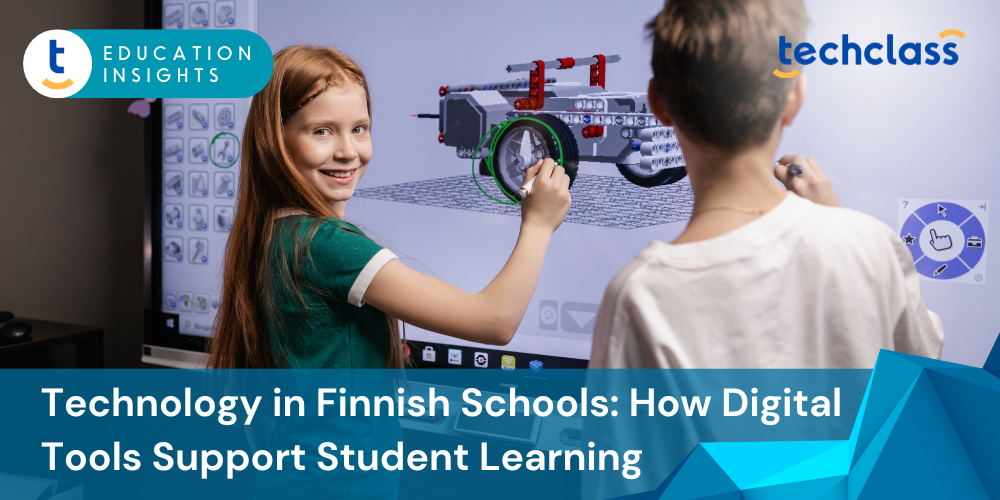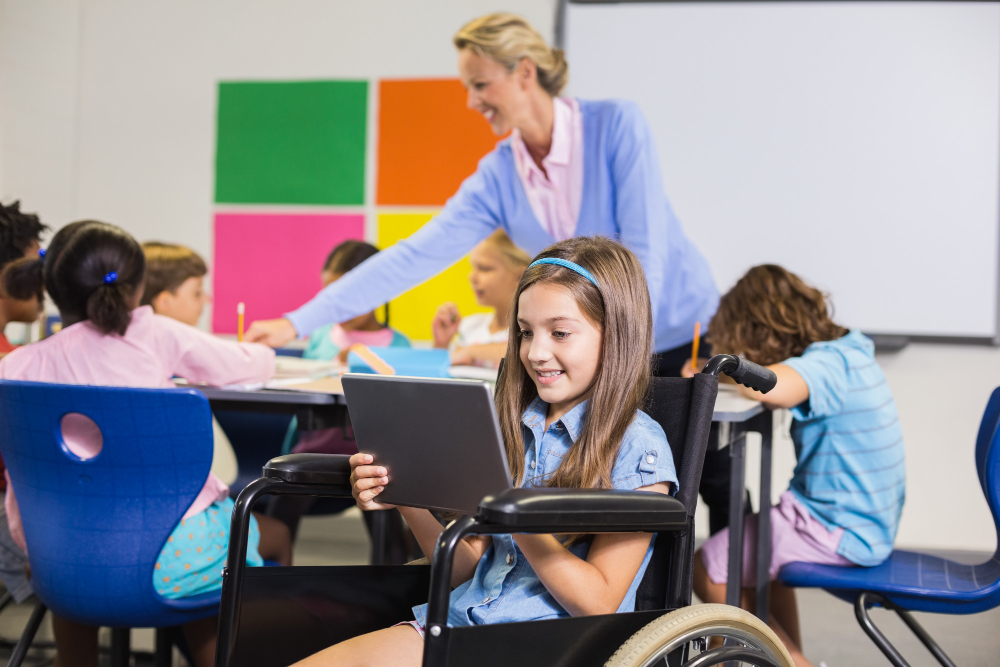Technology in Finnish Schools: How Digital Tools Support Student Learning
July 23, 2025

July 23, 2025

What if learning wasn’t limited to textbooks or chalkboards, but extended into the digital world—where children learn to code, collaborate online, and explore global knowledge with a tap? In Finland, this is the everyday reality.
Finnish schools are not just embracing technology—they are redefining how it should be used in education. With a focus on equality, creativity, and digital literacy, Finland is showing the world how smart, balanced, and responsible tech integration can help students thrive.
In this blog, we’ll explore how Finnish schools use digital tools in everyday learning, from smart classrooms to early coding education, and how these innovations shape student success. Whether you're a teacher, school leader, or parent, this journey through Finnish digital education will both inform and inspire you.
Finland’s education system is internationally recognized for being student-centered, equitable, and innovation-driven. These core values are reflected clearly in the nation’s approach to educational technology. In Finnish schools, technology is not a trend to chase, but a tool to support meaningful learning.
The country’s strategy is simple yet powerful: digital tools should enhance—not replace—human connection in the learning process. In other words, while students use tablets and laptops, the heart of education still lies in relationships, curiosity, and critical thinking. This philosophy is officially supported by the Finnish National Agency for Education, which provides schools across the country with a strong digital foundation. Whether a school is located in the capital city or a remote Arctic village, it receives equal access to high-quality digital resources, internet connectivity, and teacher training.
The Finnish National Agency for Education’s vision:
"The digitalisation of education aims to strengthen the knowledge and skills of learners and staff, promote pedagogical innovation, and ensure the accessibility and equality of learning environments."
This means technology is not added for the sake of appearance or novelty. Instead, Finland takes a strategic, research-based approach. Educational tech tools are carefully evaluated and integrated only when they support the core values of the national curriculum, which include:
A good example of this thoughtful approach is how Finnish schools avoided over-relying on screen-based tools during the digital shift. While tablets and laptops are widely used, students are also given time for offline reflection, hands-on projects, and outdoor activities, ensuring a healthy balance in their daily routines.
Ultimately, Finland sees technology not as a shortcut to learning—but as a bridge. A bridge that connects students to information, to one another, and to the skills they’ll need in a digital world.

Step into a typical Finnish classroom, and you might be surprised by what you don’t see. Gone are the rigid rows of desks, chalkboards, and passive note-taking. Instead, you’ll find open, flexible learning environments—where students move freely, sit in small groups, and use digital tools to explore ideas together. Wireless internet is a given, and digital devices are integrated naturally into the school day. Laptops, tablets, and interactive displays are as common as pencils and notebooks—but they are not used just for the sake of technology. They serve a purpose: to make learning more dynamic, personalized, and collaborative. Here’s how digital tools come to life in Finnish classrooms:
Importantly, these tools are not only for the most digitally advanced students. Finnish education emphasizes digital inclusion—ensuring that every learner, regardless of background or ability, can access and use technology confidently. Devices are provided where needed, and user-friendly platforms ensure no one is left behind.
.jpg)
In many countries, coding is still treated as a specialized subject introduced only in secondary school—or even university. But in Finland, the story is different. Coding and computational thinking begin in primary school, often as early as Grade 1. Young learners start with simple logic games and visual programming, laying the foundation for future digital fluency. As they move through school, their skills deepen naturally. By the time they reach middle school, many Finnish students can build basic games, animations, and even apps. But coding in Finland is about far more than just writing lines of code. It’s a way to develop problem-solving skills, logical thinking, and creativity. It teaches students how to break down problems, identify patterns, and build solutions—skills that are useful far beyond the computer screen.
To make this possible, Finnish schools use a range of accessible and age-appropriate tools:
What truly sets Finland apart is how real-world and community-focused these coding activities can be. In some schools, coding projects go beyond the classroom and into the community:
These are not isolated success stories—they reflect the Finnish belief that students are capable of creating meaningful, real-world solutions, even at a young age.

From the early years of school, Finnish children are guided to become not just skilled users of technology—but thoughtful digital citizens. They learn that the internet is a powerful space, full of opportunities and risks, and that using it wisely is a lifelong skill. Here are some of the key topics students explore:
This approach isn’t only the school’s responsibility. Finnish schools work in close partnership with parents to establish screen-time guidelines at home and at school. Many schools hold digital parenting workshops, where families can learn about healthy habits, device settings, and ways to support their children’s tech use.
It’s common to see school schedules where digital learning is thoughtfully balanced with:
Even in the most digitally advanced classrooms, students spend time moving, interacting, and reflecting without a screen.

Technology is only as effective as the people who use it. In Finland, this simple idea forms the backbone of digital transformation in schools. The tools themselves—tablets, apps, coding platforms—are not the focus. Empowering teachers to use them well is. That’s why professional development is a continuous and deeply embedded part of Finnish education. Rather than offering one-time workshops, Finland builds teacher growth into the daily rhythm of school life. Each school has access to ongoing training opportunities that help educators stay up to date with:
Many Finnish municipalities also support schools by appointing “digital mentors.” These are experienced teachers who specialize in educational technology and provide hands-on support to their colleagues. Whether it’s setting up a new platform, trying a classroom app, or navigating a technical issue, digital mentors are trusted guides within the school community.
And here’s where Finland stands out: teachers are treated as professionals, not technicians. They are given the trust and freedom to experiment, adapt, and innovate. There’s no rigid, top-down tech policy forcing every school to use the same tool. Instead, teachers are encouraged to choose what works best for their students.

One of the defining strengths of the Finnish education system is its unwavering commitment to equity. This value doesn’t just apply to traditional learning—it extends deeply into the country’s approach to digital education as well. Whether a student attends a school in downtown Helsinki or lives in a small village in Lapland, their access to digital tools and learning opportunities is guaranteed. There are no digital “haves” and “have-nots” in Finland. The aim is simple and powerful: every student should have what they need to succeed, regardless of geography, background, or ability. To make this possible, the Finnish government invests consistently in education infrastructure, ensuring all schools can implement digital learning. Support comes in several key forms:
Assistive technologies are widely used in classrooms across the country. For example:
These tools are not seen as special exceptions—they are simply part of the normal classroom toolkit. Teachers integrate them seamlessly into daily instruction, fostering a culture of belonging and dignity for all learners.
What’s especially powerful about Finland’s model is that technology is not treated as a luxury—it’s treated as a right. The mindset is that every child, no matter their circumstance, deserves to participate fully in the modern world. And in today’s world, that means having access to the tools, skills, and support necessary to navigate digital environments confidently and creatively.

Here are three real examples of how Finnish schools are embracing technology to create meaningful learning experiences:
Saunalahti School, known for its open architecture and future-focused curriculum, encourages students to use digital tools to solve real-world challenges. In a class project, students worked in small teams to develop mobile applications that could improve everyday life in their community. One group created a recycling-tracking app for households, while another designed an app to help peers manage their homework schedule. The goal wasn’t just to build an app—it was to think critically, collaborate, and innovate using technology.
At Koulumestari School, students as young as 9 participate in a robotics club where they build and program robots using LEGO Mindstorms. The club became so popular that the school entered—and won—local competitions. But beyond trophies, the experience taught students how to work in teams, solve technical problems, and think algorithmically. One teacher shared that a student who previously struggled in traditional lessons “found his voice” through robotics.
At Torkinmäki School in Kokkola, students use digital portfolios to track their academic and personal growth. They upload their work, record audio reflections, and set learning goals each term. These portfolios are accessible to both students and parents, creating a transparent and collaborative learning environment. Teachers have noted that students become more engaged in their own progress and take pride in curating their digital journeys.
What’s next for digital learning in Finland?
While Finnish schools are already known for thoughtful and effective technology use, the journey is far from over. In fact, Finland continues to explore new ways to enhance learning by integrating the latest advancements in educational technology, all while staying true to its core values of trust, creativity, collaboration, and equality. Here are some of the most exciting developments shaping the future of EdTech in Finnish schools:
What’s important to note is that Finland doesn’t chase trends for the sake of innovation. Every new tool is evaluated through a pedagogical lens: Does it support the student? Does it make learning deeper or more meaningful? If the answer is yes, it’s explored. If not, it’s set aside.
Despite the rapid pace of technological change, Finland remains grounded in its human-centered approach to education. Technology is never allowed to overshadow the relationships between teachers and students or the joy of discovery. Instead, it’s used to strengthen those connections and expand the possibilities of learning.

Finland shows us that the future of education isn’t about having the newest devices. It’s about using technology wisely, creatively, and responsibly—to support real learning, not distract from it.
From coding lessons in early grades to responsible screen-time and digital citizenship, Finnish schools have created a system that inspires innovation while staying true to human connection.
If you’re an educator, school leader, or policymaker curious about how digital learning can transform your classrooms…
Why not come and see it yourself?
TechClass offers personalized school visits to Finland, where you can walk through classrooms, talk to teachers, and experience this digital transformation firsthand.